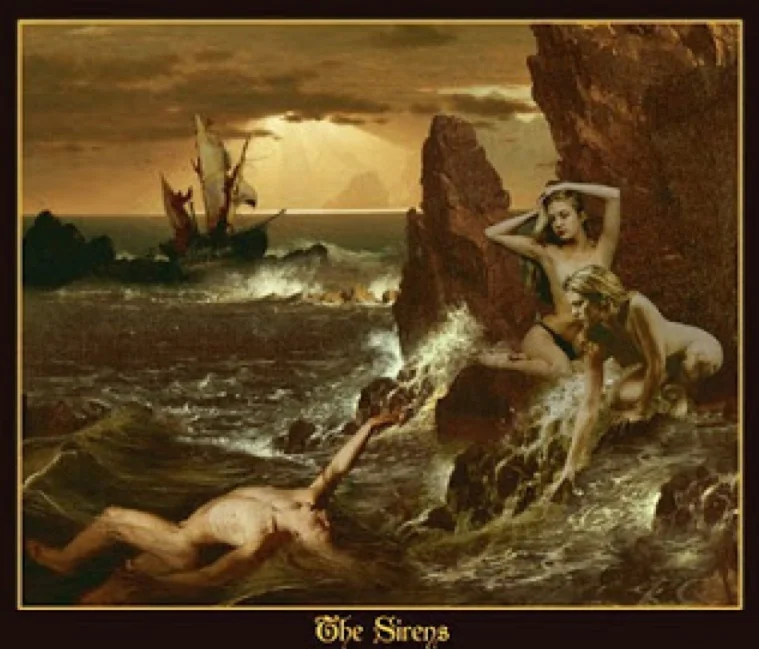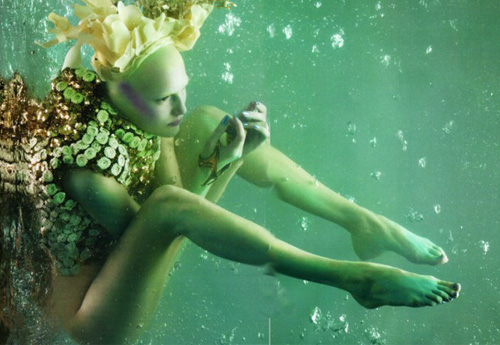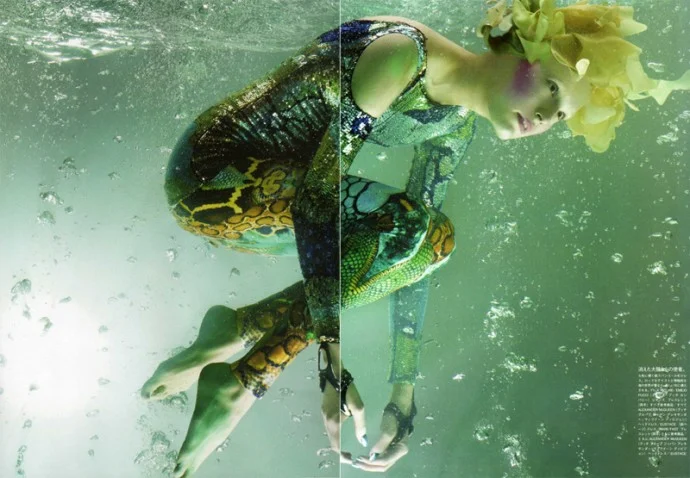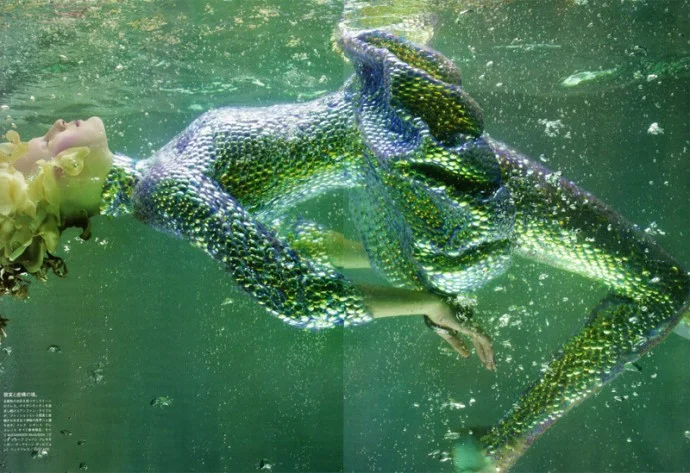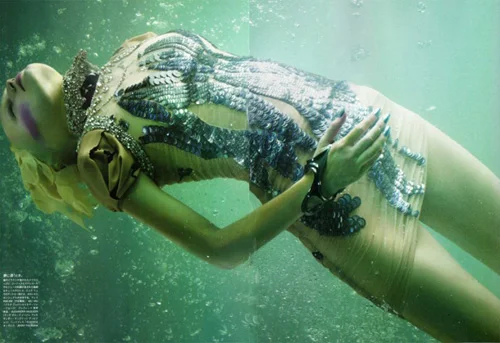Aphrodite Joins Yemaya & Mami Wata for a Swim in Human Consciousness
/It’s 30 months ago that I wrote this post about goddesses and my immersion again in studies of the collective unconscious and mythology. I had no vision of a GlamTribal jewelry collection when I joined Aphrodite and Mami Wata in a cohesive vision of female sensuality and its place in the male unconscious mind.
After a long and difficult journey for me — which is nothing compared to Mami Wata’s journey and suffering on the slave ships across the Atlantic and into Haiti and on to South America — the GlamTribal goddesses are here. And without a doubt we are swimming in the waters of human consciousness — further, deeper and with more incredible connections than I ever dreamed was possible in my life. What a spider web!! ~ Anne
Men have always been ambivalent about mermaids, the mythological aquatic creatures with a female human head and torso but the tail of a fish. In many ancient cultures, mermaids were regarded as semi-divine aspects of the Goddess.
Carl Jung’s theory of the feminine unconscious describes this oceanic-subterranean womb of creation as an unfathomable place of ancient wisdom but also fear.
The first known mermaid stories appeared in Assyria, ca. 1000 BC. The goddess Atargatis, mother of Assyrian queen Semiramis, loved a mortal shepherd and unintentionally killed him.
Distraught and ashamed, Atargatis jumped into a lake to take the form of a fish, but the waters would not conceal her divine beauty. Thereafter, she took the form of a mermaid—human above the waist, fish below—though the earliest representations of Atargatis showed her as a fish with a human head and legs, similar to the Babylonian Ea. The Greeks recognized Atargatis under the name Derketo.
Prior to 546 BC, the Milesian philosopher Anaximander proposed that mankind had sprung from an aquatic species of animal. The scientist and highly-regarded critical thinker thought that humans, with their extended infancy, could not have survived otherwise.
All sea goddesses inherit the sea’s qualities.
Just as the ocean could be gentle and nurturing, so could water be violent and deadly, a psychological expression more blatant as mermaids became the Sirens of Greek mythology.
In a larger sense, this is humans’ view of nature, including the fact that a fertilized human egg grows in a sack of embryonic fluid.
The mermaid is full of contradictions in a way that God is not. If God sends an earthquake, he has a good reason for creating such dramatic human suffering, say those who embrace an all-powerful, ferocious God who is easily displeased. Mermaids, on the other hand, are ferocious and tempestuous divine creatures, requiring male guidance to keep them from deploying their irrational female tendencies around the planet.
In Greek mythology, the Sirens — who now possessed the bodies of birds and the heads of women, lived in the caves over water, calling to men with voices so sweet that mariners who heard their songs were often shipwrecked.
To this day the fact that women cannot sing near ultra Orthodox men in Jerusalem is probably rooted in this ancient myth. Unfortunately, men have always loathed taking responsibility for an inability to steer their own boats into safe harbor, making it women worldwide who are responsible for his screw-ups. .
Mermaids preceded a single patriarchal, almighty God. Over in ancient Greece, Icarus was practicing flying into the sky, beating back the female forces of nature that threatened his destruction.
Forget Sophocles, Plato, and Aristotle — who were hardly friends to women — although the compressed decline of women from Sophocles to Aristotle is flabbergasting. An almighty, monotheistic God over in Jerusalem knew what was best for the future of civilization, and he would have his way with women, rendering them fully subordinate to men.
Mermaids went global as human societies sprung up around the world, populating the planet with the same stories and inner anxieties about life and death.
Aphrodite and Venus
In Aphrodite, mythology has one of it’s best known goddesses. Called Venus in Roman mythology, in Roman “Aphrodite” means foam-born. Beautiful as she was, Aphrodite originated in the myth of Uranus being castrated by Cronus, with the offending organ thrown into the sea.
The foam from this event gave birth to Aphrodite. And you thought Sigmund Freud invented the ‘castration complex’. The fear of women castrating men literally and figuratively began with man’s desire to live forever — if only he could fly high enough into the sky and away from earth-bound women.
There is a painting by Botticelli called “The Birth of Venus” which ignores the more unpleasant parts of this tale and shows Venus, naked except for some skillfully placed cloth, rising out of the sea in a clam shell.
According to African mythology the Supreme Being created a pantheon of gods and goddesses called Orishas. The Orishas regulate the world and act as intermediaries between men and the Supreme Being. After the Supreme Being created the world, He discovered that it had a large hole in it.
This vast hole was filled with water the Supreme Being made from some gas clouds. Enter Yemaya, a critically important goddess
In West Africa, Yemaya was the first mother, bringing fertility to the world and ruling over the oceans. Because she is the spirit of water, nothing can live without Yemaya. Her mythical DNA lives in all things — plant, animal and human.
For all these reasons and more she is called the Queen of the World.
In a cursory reading of these myths, it seems that Yemaya (aka Yemoja and numerous other related names) is celebrated as a deeply sensual creature in the original mythology.
I haven’t enough time to investigate fully black scholars’ writing vs whites’ on the West African Yemaya mythology and encourage anyone to share insights on the topic.
Personally, I don’t believe white writers are imbuing black mythology with overtly sexual stereotypes. The ancient world was highly sexual, and it’s monotheism that reduced human sexuality to a state of sin, with woman responsible for the downfall of the world.
As Mother of the Sea (thought to be the source of all life) along with the attributes of sword and fan, Yemoja expresses “what Judith Hoch-Smith calls ‘radical Yoruba female sexuality’” in the sense that this “power” of expression reveals Divine presence which is neither he nor she but an expression of pure and energetic essence, áshe (Thompson 74). Yemoja, then, appears to mediate between all pairs of opposites in conflict with each other. Yemoja represents itself archetypally through the image of the strongest tension, the “eternal struggle of the sexes in Yoruba society over control of the life force” (Thompson 74). via Mythpoetry.com
At the same time he created Yemaya and gave her domain over all the waters, the Supreme Being created her night version Nana Buruku, as the mysterious and mystical moon. This female duality regulates day and night, so that neither is too long.
Clearly Yemaya occupied the corner office, in charge of running all of life. It’s said that Yemaya and her moon goddess side control the tides and the rain. In a new basket of gifts, Yemaya also brought beauty into the world, just like Aphrodite.
Who knew a woman could have such a complete wealth of deployable talents!
Also in African mythology there is a mermaid goddess called Mami Wata (water mother). Her cult is very popular in Western and Central Africa. Slaves carried her religion to Haiti, Cuba, Central and South America. She is a goddess in the cult of Voudun (which is different from that Hollywood Voodoo nonsense).
It’s said that Mami Wata even influenced the myths of American Indians. Rest assured that I will investigate that idea, because I haven’t been the same person since my trip to Tucson over Thanksgiving. Was Frank Lloyd Wright a Mami Wata lover?
Mami Wata is described as far more than ‘just a beautiful woman’.
Her gorgeosity is so extreme, it is supernatural. Her clothes are so new they seem to shine brighter than a Marc Jacobs for Louis Vuitton collection. MW possesses unimaginable wealth and dazzling jewelry, but she’s not a Modern-values woman, lacking heart and looking for a job on Wall Street.
Mami Wata is a Smart Sensuality female with a strong connection to feminine principles, with a snake coiled around her waist, its head between her breasts — just like Lilith, Adam’s first wife. Mami Wati’s hair is black and straight, and her skin is fair which are unusual traits in African mythology.
In her mermaid form Mami Wata is naked. As a goddess of wealth she may be shown with a gold mirror or a often combing her long hair with a richly-made comb while gazing into her reflection.
Divine Goddess Future
My knowledge of mermaid as symbolic icon is limited. Being highly influenced by Carl Jung and his concept of the unconscious as female principles my entire life, I pursued a bit of research on Jung and mermaids.
Digital adventures are always full of twists and turns, and I can’t vouch for a moment as to the accuracy of the argument that Disney’s ‘Little Mermaid’ Ariel is (unknowingly I assume) a symbol of Mary Magdalene.
The thesis that Jung believed the patriarchy would eventually burn itself out, because life cannot exist in such a state of imbalance between feminine and masculine principles is correct.
Having opened a Pandora’s box here at the bottom of the sea, I’ll leave it alone for now.
If you’re a brave soul or bored as a bat, you can share my reading. Anne
More reading:
The ‘Little Mermaid’ and the Archetype of the Lost Bride by Margaret Starbird
Jung and Heraclitus by Mark L. Ditson
The Divine Feminine, Unveiled by Elizabeth Debold
Yemaya-Olokun by Stephanie Pope
